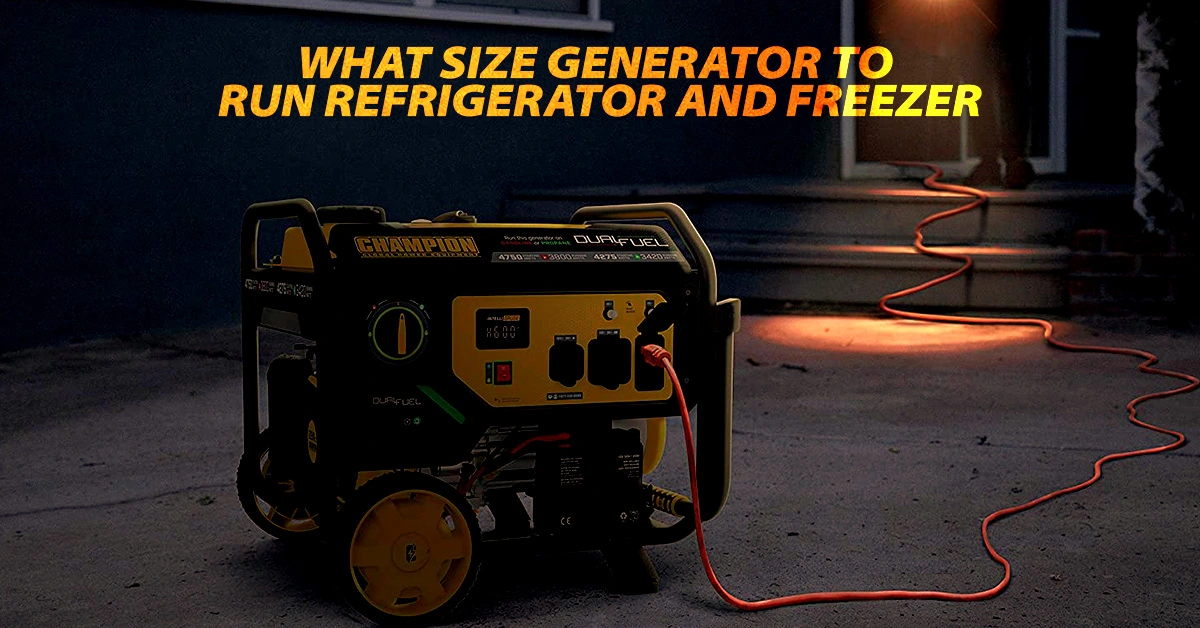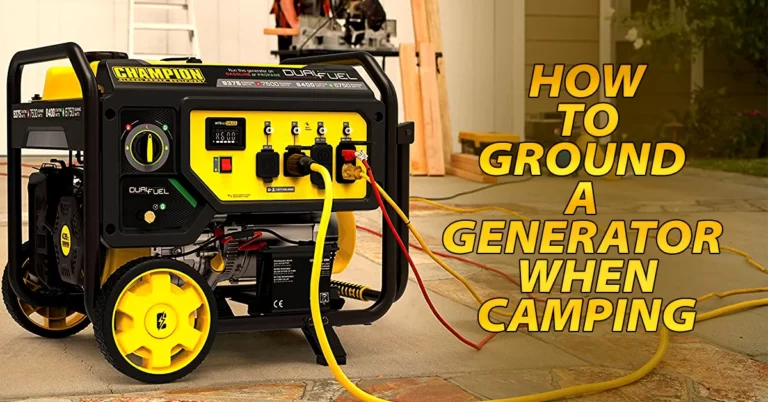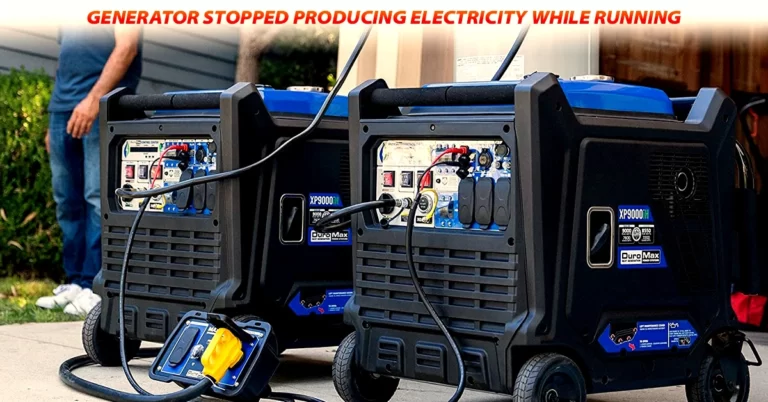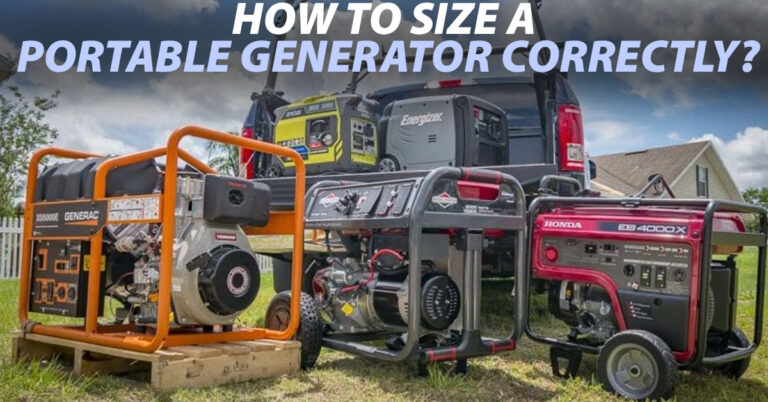What Size Generator To Run Refrigerator And Freezer
Some of the most popular appliances in homes are refrigerators and freezers. Knowing what size generator to run refrigerator and freezer can help you pick the best generator for your needs and ensure that your food remains cool during a power outage.
We’ll talk about the size of the generator required wattage to power a freezer or refrigerator. We can thus assist you whether you’re seeking to purchase a generator for the first time or are just unsure what size you want for your equipment.
Factors To Consider When Choosing A Generator Size To Run A Refrigerator And Freezer
Factors to consider when selecting a generator size to operate a refrigerator and freezer:
The power needs of the refrigerator and freezer
The amount of generator required is mostly determined by the power needs of your refrigerator and freezer. On the website of the manufacturer or in the user guide, you can often find information about these appliances’ power consumption.
Wattage Of The Refrigerator And Freezer
When choosing a generator to power a refrigerator or freezer, wattage is a crucial consideration. To find out the precise wattage, it’s crucial to review the specifications of the particular brand of freezer and refrigerator you want to use. It’s also worth noting that power needs vary depending on whether the appliance is in cooling or defrost mode, as well as the age and condition of the device.
Voltage And Amperage Requirements
Another crucial consideration when choosing a generator is the voltage and amperage needs of a refrigerator or freezer. The normal voltage needed for a basic domestic refrigerator or freezer is 120V. The amperage requirement may be found in the specifications of the appliance and is measured in amperes (A) or amps. Depending on the size and kind of device, a refrigerator or freezer may need a different amount of amperage. Make sure the generator you choose can provide the appropriate voltage and amperage to power your freezer or refrigerator. Inadequate voltage or amperage might result in poor performance or even damage to the device.
The duration of usage for the generator is
The size required will also depend on how long the generator will be in operation. A generator that will be in use for a brief time won’t need as much power as one that will be used for a long time.
The place and environment in which the generator will be used:
The size of the generator required might also be influenced by the environment and area where it will be deployed. For instance, a generator used in a cold region will need more energy to run than one used in a warm one.
The Availability Of Fuel For The Generator
Another crucial factor is the availability of fuel for the generator. In a location where fuel is hard to come by or is rare, a generator that uses a lot of fuel may not be viable.
The Backup Time
The size of the generator you require also depends on how long of a power outage you are anticipating. The appliances will need to be kept running on a bigger generator if the projected duration of the power outage is longer.
The Starting And Running Wattage
The starting and running wattage of the generator is also vital to consider. The refrigerator and freezer will need beginning watts to start the compressor, and operating wattage to keep it running. The generator must be able to produce both the starting and operating power for the appliances.
Other Loads That Need to Be Powered Include
In addition to the refrigerator and freezer, the generator will also need to power lighting and other appliances. When choosing the generator size, certain loads should be considered.
What Size Generator Do You Need To Run A Refrigerator And Freezer?
To determine what size generator you will need, here are some things to keep in mind:
Wattage Of Your Refrigerator And Freezer
You must calculate the total wattage and amperage demands for all appliances and gadgets that will be operating simultaneously to establish the size of the generator required to operate a refrigerator and freezer.
The Starting And Running Wattage
Check the model’s specs to first ascertain the starting and running wattage of the refrigerator and freezer. The amount of electricity used by a gadget to operate continuously is known as the “running wattage,” while the amount of power needed to start it up is known as the “starting wattage.”
Here is the whole list of refrigerator wattages. Check how many running and starting watts your refrigerator and freezer have:
| Refrigerator And Freeze | Starting Watts | Running Watts |
|---|---|---|
| Small-Mini Fridge | 200 watts | 50 watts |
| Big-Mini Fridge | 400 watts | 100 watts |
| Standard Energy-Star Fridge | 768 watts | 192 watts |
| Small Fridge | 1,200 watts | 400 watts |
| Standard Fridge | 2,900 watts | 700 watts |
| Biggest Fridge | 6,000 watts | 1,500 watts |
| Big Side-By-Side Fridge | 4,000 watts | 1,000 watts |
Calculating The Total Wattage And Amperage Requirements
Next, add the beginning and operating wattages of the refrigerator and freezer to get the needed total wattage.
For example, if your refrigerator requires 800 watts of running wattage and 1500 watts of starting wattage, and your freezer requires 500 watts of running wattage and 1000 watts of starting wattage, you’ll need a generator that can handle at least 800 + 500+1500+1000=3400 watts.
Next, review the model’s specs to establish the amperage needs of the refrigerator and freezer. To get the total amperage needed, add the amperage needed for the freezer and refrigerator together.
Selecting A Generator That Can Handle The Total Wattage And Amperage Requirements
Once you know how much overall wattage and amperage you’ll need, you can choose a generator that can meet those needs. To make sure that the generator can handle any possible rise in wattage or amperage during start-up or defrost mode, it’s crucial to choose one with a larger output than the entire amount of wattage and amperage needed.
It’s crucial to remember that this is only an example, and the precise amount of generator required may vary based on the individual appliances and gadgets you want to operate.
How To Calculate Wattage Requirements
As a practical example, here is how to calculate your minimum wattage requirements:
- On average, a standard refrigerator requires 600 watts. As a result, it will consume 600 Wh for every operation hour (watt-hours). A 10-hour operation of a freezer will consume 600 Wh multiplied by 10. (watt-hours). 6000 Wh + 600 Wh = 6600 Wh if the freezer and refrigerator are both operating (watt-hours). Your generator should have a minimum operating capacity of 6.6 kWh (kilowatt-hours).
- Another practical example: It may be a refrigerator plus a chest freezer or one huge upright freezer if your appliances utilize a combined 8 kWh for cooking, heating, and other daily purposes. The device may run up to half that time on an 8 kWh generator without adding a generator to the load.
Suitable Size Generator To Run Refrigerator And Freezer
- Most households operating a refrigerator, freezer, and other appliances simultaneously without tripping an overload circuit breaker should be able to do so with a 10 kW generator. To avoid overloading them, all the generators you use should be the same size. Before buying a generator, be sure to determine your wattage needs.
- A transportable inverter generator is an additional choice for the house. Appliances with motors or heating components, including a stove, furnace, and more, may be powered by a 12,000-watt inverter generator. The advantage of an inverter over a typical generator is that it maintains a steady 120 Volt AC voltage. Inverter generators are perfect for starting delicate equipment, such as computers and TVs.
However, you will need a generator with a transfer switch to power a sizable oven or commercial refrigerator in your restaurant or company that needs heavy-duty 240 volts of electricity. As a result, the appliance will be able to supply a 240 VAC appliance with a dedicated circuit while still operating on 208 VAC. A generator that can run a commercial refrigerator of this size would need to be considerably more powerful—at least 25 kW–75 kW.
When you need electricity the greatest, the proper size generator will provide it without overloading it or harming refrigerators or any appliances. Many generators with capacities ranging from a few kilowatts to hundreds of kilowatts are available for residential and commercial usage.
Some generators can even be linked to solar energy systems so that they are off the grid. Before investing in a generator, make sure to determine your wattage needs.
Which Is The Best Generator For A Refrigerator And Freezer?
DuroMax XP12000HX Dual Fuel Portable Generator

A strong generator that can produce up to 12000 watts of electricity is the DuroMax XP12000HX Dual Fuel Portable Generator. It has a brand-new control panel with a digital multimeter, push-button ignition, and a fuel interface on the front that lets you quickly switch between different types of gasoline. It may operate on gasoline or propane, providing you with the freedom and flexibility of fuel choice. The generator is fitted with DuroMax “CO Alert Technology,” which will automatically shut down the generator if an unhealthy quantity of carbon monoxide is detected. It is constructed with a strong 460 cc OHV DuroMax engine and has all-copper windings that are intended to extend the generator’s lifespan. The fully loaded power panel has four 120V GFCI home outlets, one 120V 30AMP outlet, one 120/240V 30AMP twist-lock outlet, and a heavy-duty 120/240V 50AMP outlet, making it transfer switch ready. It could be a dependable choice for operating a refrigerator and freezer. Check out this amazing machine on Amazon.
Pulsar G12KBN Heavy-Duty Portable Dual Fuel Generator

When using gasoline, the Pulsar G12KBN Heavy Duty Portable Dual Fuel Generator can produce up to 12,000 peak watts and 9,500 rated watts, and when using LPG, it can produce 10,800 peak watts and 8,550 rated watts. Due to its dual fuel capacity, which lets you select between LPG and gasoline fuel, it may be helpful in emergency circumstances or during natural catastrophes. A sturdy, powder-coated frame guards the generator’s 457cc, single-cylinder, 4-stroke, air-cooled, OHV engine with an electronic start. With an 8-gallon fuel tank, it can operate continuously for up to 12 hours at half load while using gasoline. It contains (4) 120V 20A AC outlets, (1) 120V/240V 30A twist-lock outlet, (1) 120V/240V 50A outlet, (1) 12V DC output that provides adequate space for powering appliances, tools, and other items. For increased mobility and simple storage, it includes 10″ never-flat wheels and handy drop-down handles. with automated voltage regulation, a 3-in-1 digital meter, and low oil shut-off for less effort and anxiety. It’s covered by a 1-year limited warranty; check out the best price on Amazon.
Briggs & Stratton P4500 Portable Generator

A 4500-watt generator, the Briggs & Stratton P4500 Portable Generator offers the power you want for RV and camping usage. It includes a push-button electric start for fast and simple starting with an adjustable, manual choke. This generator has 3700 operating watts and 4500 starting watts, which is sufficient to power a freezer and a refrigerator. It boasts a multipurpose display screen that keeps an eye on run duration, fuel level, and power consumption. It also incorporates CO Guard carbon monoxide shutdown technology that shuts off the generator when hazardous quantities of carbon monoxide are detected. You may continue using electricity for longer since it can operate for up to 16 hours at 1/4 load. This generator is 60% quieter than a conventional generator, which is compared to the Briggs & Stratton standard generator 030743. It has (2) USB ports, (1) 120V, 30A RV outlet, and four 120V, 20A outlets, allowing you to charge many devices at once and remain connected. Check Amazon for the best price.
Westinghouse 7500 Watt Home Backup Portable Generator

The Westinghouse 7500-watt home backup portable generator is a strong generator that generates 7,500 peak watts and 6,000 operating watts. It includes an electric and recoil start and has a run duration of up to 13 hours on a 6.6-gallon gasoline tank with a fuel gauge. This generator contains two GFCI (ground fault circuit interrupter) 5-20R 120V household Duplex receptacles and one transfer switch ready L14-30R 120/240V twist-lock receptacle; all outlets have rubber covers for extra safety. It’s a plug-and-play generator that comes with oil, an oil funnel, a tool kit, and a user’s handbook to get you started straight out of the box (minimum assembly necessary) (minimal assembly required). It’s driven by a 420-cc Westinghouse 4-Stroke OHV Engine boasting a long-lasting cast iron sleeve with an automatic low oil cutoff and a digital hour meter. It’s EPA and CARB compliance, supported by a 3-year limited service, labor, and parts coverage, and a national customer care network. Check out the best price on Amazon.
YAMAHA EF2200iS Inverter Generator

A Yamaha 79-cc engine provides 2200 watts of electricity to the Yamaha EF2200iS inverter generator. It produces a lot of power and has Yamaha’s high-tech muffler for quiet operation. This generator features a conventional RV plug and a DC outlet, providing versatility to charge and operate electronics. You can quickly determine the generator status both during the day and at night thanks to its lighted multi-function LED display. It incorporates a smart dial knob for quick and easy start-up and a smart throttle that automatically adjusts power to devise demands. Powering a freezer and refrigerator it can be a dependable choice. Its power output, however, is insufficient to power both appliances at once. Check Amazon for the best price.
Conclusion
Before investing in a generator, make sure to determine your wattage needs. Ask the professionals at Generator for assistance in selecting the ideal size generator to power your refrigerator and freezer if you’re unsure of your demands.
FAQs
-
What Size Generator Will Run My Refrigerator?
While a freezer only requires up to 3.3 kWh for 24 hours, your refrigerator consumes 6.6 kWh (kilowatt-hour) to operate. Before investing in a generator, make sure to determine your wattage needs.
-
What Size Generator Will Run My Refrigerator And Freezer At The Same Time?
On average, a standard refrigerator requires 600 watts. As a result, it will consume 600 Wh for every operation hour (watt-hours). A 10-hour operation of a freezer will consume 600 Wh multiplied by 10. (watt-hours). 6000 Wh + 600 Wh = 6600 Wh if the freezer and refrigerator are both operating (watt-hours). Your generator should have a minimum operating capacity of 6.6 kWh (kilowatt-hours).
A portable inverter generator is an additional choice for providing steady electricity to delicate devices like computers. -
What Size Generator Will Run My Commercial Refrigerator?
You need a generator with a transfer switch if you have heavy-duty 240-volt appliances in your restaurant or business, such as a big oven or a commercial refrigerator. As a result, the appliance will be able to supply a 240 VAC appliance with a dedicated circuit while still operating on 208 VAC. A generator that can run a commercial refrigerator of this size would need to be considerably more powerful—at least 25 kW–75 kW.
-
What Size Generator Will Run My Whole House?
25 to 75 kW are needed to power a home using a generator. Inverter generators are a fantastic option for powering delicate items like computers since they are more energy-efficient and gentler on the generator itself.







